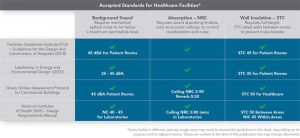
In simple terms, this study showed the patients’ recovering hearts did not have to work as hard when highly sound-absorbent ceiling panels were overhead. Patients were also more satisfied with the care provided by the staff during the good acoustic conditions. Importantly, the incidence of re-hospitalization was lower among the patients treated during the good acoustic conditions. This is not only a quality improvement, but also a financial savings.
HCAHPS patient satisfaction survey
According to CHD, hospital noise levels have been rising consistently since the 1960s. The different aspects of sound impacting patients, staff, and visitors in hospitals include noise, speech privacy, speech intelligibility, and music.
For patients, negative outcomes range from annoyance to elevated blood pressure and decreased wound healing. In one study, more medications were required by surgery patients post-recovery when noise levels were more than 60 dB(A).
“These issues associated with sound control and transmission are interrelated, and different environmental design strategies have proven successful in mitigating negative effects of noise while allowing effective verbal communication.”
Approximately 10 years ago, the U.S. Centers for Medicare and Medicaid Services (CMS) launched a pay-for-performance reimbursement program to decrease medical costs and to improve the quality of healthcare. One of the lowest-scoring questions on the CMS Hospital Consumer Assessment of Healthcare Providers and Systems (HCAHPS) satisfaction survey asks patients, “How quiet was the area around your room at night?” This simple question ties all the important components together—ceilings, noise, sleep, outcomes, and cost.
Medicare reimbursements are tied to the portion of the HCAHPS survey that asks about patient satisfaction. Higher-performing healthcare facilities generally receive greater financial reimbursement.
Impact of acoustics on doctors, nurses, and hospital staff
High noise levels also have serious impacts on caregivers and staff. When a caregiver becomes accustomed to constantly hearing medical equipment beeps and alarms, the sound becomes ambient and they inadvertently can ignore it. When overall noise is reduced, the stress levels in healthcare staff are also minimized, allowing them to recognize, identify, and locate those important alarms.
According to CHD, a few studies have examined work performance by anesthesiologists and surgeons under quiet versus simulated noisy conditions. One study found short-term memory and mental efficiency declined among anesthesiologists working under typical operating room conditions with noise levels over 77 dB(A). The investigators found, under these conditions, the threshold level for speech reception increased by 25 percent, suggesting that speech communication was possible only by raising one’s voice and, at the same time, speech discrimination reduced by 23 percent.
Noise can be a source of stress for hospital staff and may interfere with their ability to work effectively. In a Swedish study on the impact of room acoustics, the researchers found, during better acoustical conditions, the staff reported feeling less stress, pressure, and strain. One study found a relationship between noise-induced stress and nurses’ experiencing emotional exhaustion and burnout. Another study showed nurses’ feelings of stress and annoyance increased with noise. In another study, healthcare staff perceived the excessively high noise levels in the workplace interfered with their work and impacted patient comfort and recovery.
Achieving high-performing acoustic ceiling design
Acoustic absorption occurs when an architectural surface—such as a suspended ceiling, wall-mounted panels, or carpet—converts energy in sound waves into insignificant heat energy by means of friction inside the pores of the material. The more sound energy is absorbed by the surface, the less is reflected back into the room as problematic noise and reverberation.
One of the priority evidence-based design recommendations is to use high-performing, sound-absorptive ceiling panels in healthcare facilities due to the strength of the evidence available and their impact on safety, quality, and cost. The studies supporting this design recommendation utilized ceiling panels that were at least 90 percent sound-absorptive, or having a noise reduction coefficient (NRC) 0.90 or higher.
The crossover point, whereby ceiling panels stop being mostly sound-reflective and start becoming sound absorptive, can be shown using color maps. The colors superimposed over the ceiling images in Figure 1 represent loudness of the noise reflecting off the ceiling.




